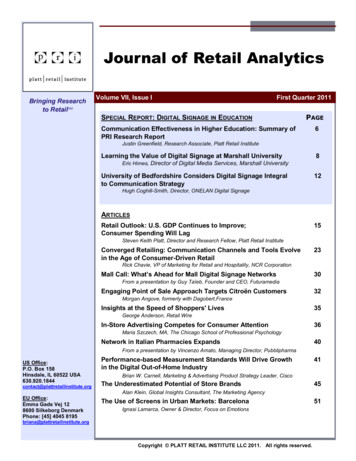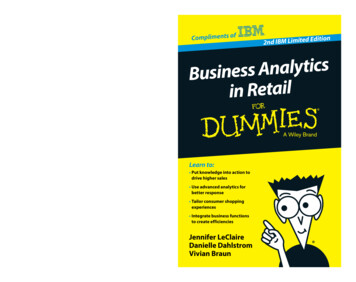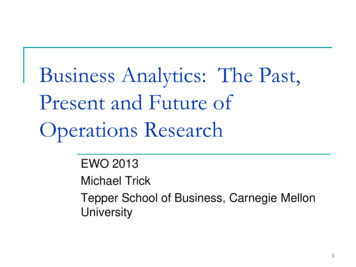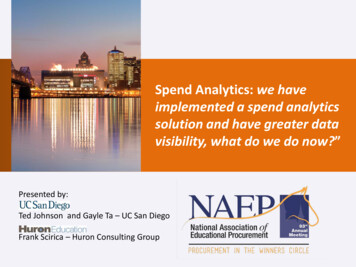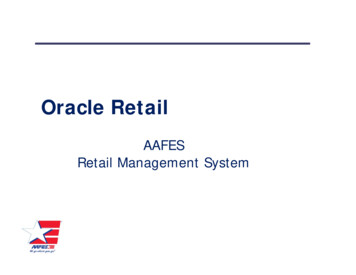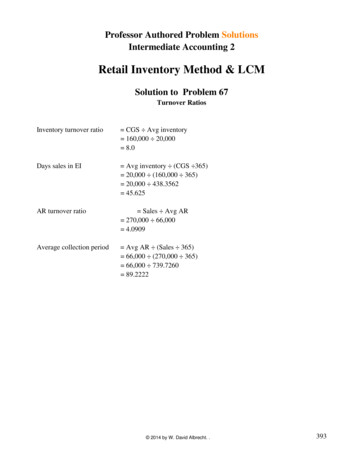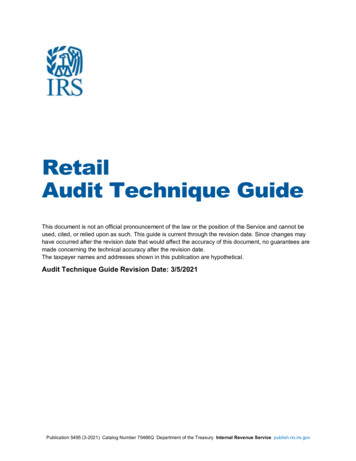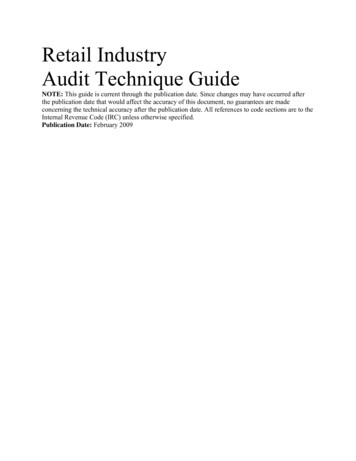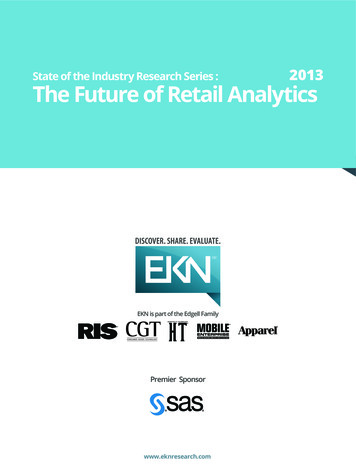
Transcription
State of the Industry Research Series :2013The Future of Retail AnalyticsEKN is part of the Edgell Family Premier Sponsorwww.eknresearch.com
Table of ContentsExecutive Summary3The Future of Retail Analytics: From Intelligence to Outcome6Research Findings12Recommendations30EKN Analytics Maturity Assessment Framework (Excerpt)34Retail Analytics Vendor Landscape37
Executive Summary
EKNExecutive SummaryRetail has always been a data-intensive industry. As the tools available to store, manage and analyze thisdata evolved, so did the role the analysis of data played in retail decision-making. From visibility and control,to transparency, to efficiency, to customer engagement.It is cheaper, faster and easier today to store and process more data than ever before. Retailers have gottenbetter at data management. Question is, how well are they able to leverage insights from this analysis todrive strategic decisions?EKN conducted an industry survey to benchmark the state of the retail industry in terms of analytics maturity. Findings from the primary research covering 65 respondents, interview based qualitative inputs fromretail executives, and EKN’s secondary research from public and proprietary sources are presented in thisreport.In a retail environment where consumer spending is stunted and competition from newer, digital channelsis eroding store sales, the route for brick and mortar retailers to earn a larger share of wallet of the customeris through deeper, Omni-channel customer engagement. Customer engagement is only as effective as howwell you know the customer and how well you are equipped to act on that insight across your channels.Perhaps this is why customer insight emerges as retailers’ highest-priority goal from analytics initiatives in2013. In addition, findings from EKN’s survey include: Retailers’ analytics maturity is low: 2 in 5 retailers state they lag behind their competitors interms of their analytics maturity and a further 2 in 5 suggest they are at par. The “analytical retailer”is thus the exception rather than the rule. Data management and integration will be a key area of investment in an effort to increase analytical maturity. Retailers are looking to integrate a variety of data sources over the next 2 years,however public and open data remains a relatively under-explored opportunity. Retailers find their current analytics organizational setup sub-optimal. Only 18% currentlyhave a shared services model for analytics in place whereas approximately 60% would like to movetowards such a model. Retailers will invest in contextual, visual and mobile-friendly delivery of insights to combat thebiggest challenge that prevents them from leveraging analytics strategically – delivery of insights tothe right resource at the right time. Retailers’ eCommerce or Omni-channel function emerges as the business function with thehighest potential opportunity for analytics impact, the highest rate of data growth and the highest planned technology investment. However, it is also currently the function with the lowest analytics maturity. Usability is the most important feature retailers will look for when choosing analytics solutionsin 2013. Even with the delivery of insights being their biggest challenge, mobile or tablet accessranks relatively low.4
5State of the Industry Research Series: The Future of Retail AnalyticsExecutive SummaryThe traditional view of data management and analysis in retail has been tool-driven – be it relational databases of decades past or Business Intelligence tools more recently. In EKN’s view, “business analytics” is aconcept that focuses on decisions and outcomes, and is a far better indicator of the future of retail analytics.Inside the report: EKN’s Business Analytics Software VendorLandscape The Analytics Honor Board EKN’s Analytics Maturity Assessment Framework (Excerpt)Research Findings Fast Facts: Retailers rate Amazon, Wal-Mart and Targetas leaders in customer analytics 84% of retailers employ data analysts Web or Social Media Analytics software isexpected to have a 96% install base amongsurveyed retailers over the next 2 years
EKNThe Future of RetailAnalytics:From Intelligence toOutcome6
7State of the Industry Research Series: The Future of Retail AnalyticsThe Future of Retail Analytics: From Intelligence to OutcomeWhat’s in a Name?Retail technology terms are an etymologist’s delight. What is the difference between Business Intelligenceand analytics? Between analytics and Big Data analytics? Far from being trivial, the distinction is importantfor retailers to know, especially those in conversation with software providers who classify themselves asproviding solutions in one or the other of these areas.Business Intelligence refers exclusively to tools and software focused on retrieving, analyzing and reporting data stored in an existing enterprise database such as a data warehouse or data mart. BI tools typicallyfocus on querying, reporting, On-Line Analytics Processing (OLAP) and alerts. They help answer the questions – what happened, how many, how often, where the problem is, and what actions are needed.1Analytics is a more ambiguous term since it overlaps with Business Intelligence in that BI tools play an activerole in analytics. EKN sees the term analytics comprised of two distinct ideas, both of which are important tounderstand separately – business analytics and analytics software.Business analytics is the art, science and philosophy of utilizing insights to improve decision-making in the context of a particular business function or process. It is focused on a continuous, ongoing, and iterative exploration of past business or business process performance to gain insight, drivebusiness planning, and deliver a particular business outcome.Analytics software is a class of tools that leverages data to create context-rich, actionable insight.Compared to Business Intelligence tools, analytics software typically have improved visualization,the ability to work with real-time data, and include additional functionality such as forecasting, regression, and modeling. Business analytics is focused on the questions – why is this happening,what if the trends continue, what will happen next (predict), and what is the best that can happen(optimize)2. Jeremy Kirk of IDG News Services provides a good example3 of a customer trying towithdraw money from a cash machine as illustrative of how application of analytics must influencea specific action. “The data being leveraged is a bank account balance, the process is the withdrawal,the context-specific insight is the fact that the customer has no overdraft protection, and the actionis the confiscation of the debit card.”In its State of the Industry Research on Big Data in Retail4, EKN defined Big Data as collectively referring tothe strategy, business processes, tools and technologies that pertain to datasets whose size and complexityis beyond the ability of typical database software tools to capture, store, manage, and analyze.1234International Institute of Business AnalysisInternational Institute of Business AnalysisAnalytics buzzword needs careful definitionEKN State of the Industry Research, Big Data in Retail
EKNThe Future of Retail Analytics: From Intelligence to OutcomeAnalytics in Retail: A Historical ContextRetail is a data-intensive industry. We serve millions of customers, move hundreds of thousands of items,stock thousands of SKUs in hundreds of stores, in pursuit of that one goal – a profitable relationship withcustomers.For decades retailers have focused on data and its analysis to drive improvements in core business processes and to improve operational decision-making. With advances in analytical tools and an improved understanding of the value of such tools, the functions that benefitted most were Supply Chain, Finance andMerchandising. Even recently, Marketing’s adoption of web and social media analytics was initially drivenmore from a channel performance measurement and improvement perspective, rather than a need to understand consumer behavior and preferences better.Not only have the volume (amount), variety (different sources and types) and velocity (the speed at whichthis data flows through the enterprise’s decision making processes) of data that a retailer needs to processthrough its business information systems increased exponentially over the last few years, retailers’ goalsfrom the analysis of this data have also changed dramatically. From being focused on transparency, efficiency and business agility, retailers now need to focus their analytics efforts on customer insight andengagement.In the new normal of retailing where the consumer is value-conscious, always-on, mobile-enabled, sociallyactive and channel-agnostic, retailers are finding it difficult to differentiate themselves based on traditionalfactors such as price, promotions, location and assortment alone.On the other hand, with consumers themselves reliant ontechnology – personal computers, tablets, mobile and smartphones, the Internet, and social media – they are leavingbehind digital breadcrumbs and displaying their “digital bodylanguage”. Combined with how consumers interact withretailers across their own channels, loyalty programs,promotions and customer service, this mass of consumer dataoffers retailers their best chance yet to really know theircustomer.From being focused ontransparency, efficiency andbusiness agility, retailers nowneed to focus their analyticsefforts on customer insight andengagement.Knowing the customer better than competition and having the ability to orchestrate business decisions atthe speed of insight is the new retail competitive battlefield, and business analytics, not Business Intelligence,can be one of the strongest weapons in a retailer’s arsenal.Business analytics will only evolve further into a strategic capability that sits at the intersection of customerpreferences, business strategy and business processes. Insights will be deeply embedded across a retailer’sfunctional value chain, affording it both the ability to be investigative and predictive (strategic), as well as theadeptness to be efficient and agile (operational). Therein lies the future of retail analytics.8
9State of the Industry Research Series: The Future of Retail AnalyticsThe Future of Retail Analytics: From Intelligence to OutcomeAnalytics Through the Ages:Wave 1:Wave 2:Wave 3:Wave 4:Visibility andControlInfrastructure andOperationsExecution andExcellenceCustomerEngagementAnalytics AgeStone AgeBronze AgeIron AgeModern AgeFocused onImproving visibilityinto key aspects ofstock and salesIntegrating dataacross businessfunctionsBuilding anenterprise datarepositoryGleaning customerinsights fromenterprise andexternal dataBuzzwordSpreadsheetDecision SupportSystem (DSS)OptimizationBig DataBusiness FocusInvestment WaveDefining momentNew RetailerTarget/DaytonHudson(1902)Kroger decides toparticipate in theexperimental UPCprogram (1970)Wal-Mart’s databasein 1999 is said to be200TB, one of thelargest in the tion thatit is a technologycompany first (2011).Target predicts ateen is pregnant,before her fatherknows. (2013)Apple Store(2001)
EKN 10The Future of Retail Analytics: From Intelligence to OutcomeFrom Business Intelligence to Business AnalyticsIn a recent point of view, EKN describes the convergence of4 key trends that is reshaping retail, including an explosionof consumer and enterprise data that dwarfs anything we,as an industry, have ever dealt with before.Knowing the customer betterthan competition and having theability to orchestrate businessdecisions at the speed ofinsight is the new competitivebattlefield of retail.Yet, the biggest challenge facing retailers isn’t managing thevolume or variety of data. It is having the ability to identifywhat business outcomes they can impact through theintegration and analysis of this data, and the executioncapability to glean relevant insights and deliver them to the relevant person to be able toact on them at the right time.At different levels of maturity and to varying degrees of success, leading retailers such as Best Buy, CVS,Amazon, Target and Wal-Mart among others are leveraging analytics to: Gain a deeper understanding of their customers’ behaviors, needs and preferences to build a morepersonal relationship. Improve marketing effectiveness through micro-targeting, personalization and delivery of contextand channel sensitive promotions and offers that increase the likelihood of purchase. Optimize the supply chain to ensure the most profitable outcome in terms of demand fulfillmentbalanced against cost of carrying excess inventory. Determine pricing, including bundle and basket pricing, based on the value customers attach totheir needs at any given time. Spot flash trends, such as a celebrity sighting in a particular pair of jeans, that have an impact ondemand to be able to turn them into revenue capturing opportunities.Even as such industry leaders evolve their business structures, strategies, tools and resources in an effortto embed analytics into the very fabric of the organization, most retailers, by their own assessment (43% inEKN’s survey stated they lagged behind competitors in their strategic use of analytics), are still struggling withwide ranging issues that prevent them from leveraging analytics strategically.
11State of the Industry Research Series: The Future of Retail AnalyticsThe Future of Retail Analytics: From Intelligence to Outcome They are overwhelmed by a data tsunami (from POS systems, enterprise transactional data, machine logs, loyalty data, unstructured and semi-structured data from emails and machine logs, social media data) and are unable to build a data management and integration strategy best alignedwith their format and business goals. They find the multitude of software types and an increasingly crowded vendor landscapeconfusing. And, in an environment where investments in IT are justifiably scrutinized, some mayfind themselves battling for internal justification and investment due to failed ROI metrics fromprior analytical tools. Business Intelligence, as defined above, is tool dependent, whereas business analytics depends asmuch on the organization’s culture and outlook towards analytics as it does on tools. Most retailershave adopted BI tools as a matter of natural progression of systems. BI tools can thus offer insightsthat can prompt bottom-up change. A culture of business analytics, however, has to be driven fromthe top down. Some retailers may find it difficult to truly embrace “analytical retail” due to theirmanagement’s archaic or under-informed outlook towards analytics. The single biggest stumbling block facing business analytics is the lack of skilled resources thatcan help retailers make sense of data and contextualize insights for improved decision making. A related issue that is as important is how business analytics teams are structured in the enterprise.Retailers are struggling with how their teams and resources are currently structured, a factthat is borne out by findings from EKN’s research, presented in a subsequent section of this report. Another skill related issue for retailers is re-training existing employees who perform roles thathave transformed to be increasingly dependent on analytics. Traditionally, some of these roles mayhave been seen as art more than science, which makes the issue even more complicated given thepersonalities involved. Such roles include retail marketers, buyers and merchants.EKN Analytics Maturity Assessment Framework (Appendix A) provides a quick reference method for retailersto benchmark where they stand.
EKN 12Research Findings
13State of the Industry Research Series: The Future of Retail AnalyticsResearch FindingsSurvey respondent distribution by segment(Figures are percentage of total respondents)8%5%6%43%Apparel & AccessoriesSpecialty RetailFood & Grocery12%General Merchandise StoresOnlineOthers26%Survey respondent distribution by annual revenue(Figures are percentage of total respondents)11%19%Less than 100 million 100 million to 499 million29% 500 million to 999 million25% 1 billion to 4.9 billion 5 billion and more16%Survey respondent distribution by designation(Figures are percentage of total respondents)17%31%CXOSVP or VP24%DirectorManager28%
EKN 14Research FindingsRetailers’ customer analytics maturity remains low, even with customerinsights being their topmost priorityMost important goals from analytics initiatives in 2013(Scores represent weighted average ranking, 1 being the lowest and 6 being the highest)Improve customer insight5.04.0Improve operational efficiency3.4Increase business agility3.1Predict business performance2.8Spot future business trends2.7Improve operational transparency12345How would you describe your organization’s use of customer analytics compared to your competitors?(Figures are percentage of total respondents)Better than our competitors17%0At par with competitors43%40%2040Lagging our competitors60801006
15State of the Industry Research Series: The Future of Retail AnalyticsResearch FindingsAnalytics maturity across business functions(Figures are percentage of total respondents)Predictive analyticsInvestigative ocurementMulti-channelHuman ResourcesCustomer 23%36%17%3%26%35%25%3%27%34%14%6%22%39%29%StoresNo analytics32%21%16%Basic reporting36%30%Customer Insights 3%Supply ChainBasic analytics31%39%38%11%17%20%28%By a large margin, retailers rate improving customer insight as their #1 objective from analytics initiatives in2013. Yet, few retailers rate themselves better than competition in terms of their use of customer analytics.43% consider themselves lagging behind competition, while 40% state they are at par with their competitors.Clearly, those that consider themselves leaders in this space are few and far between.Further, retailers’ analytics maturity varies by function, and Customer Insights ranks low, with 2 in 3 retailersable to conduct “basic” analytics at best. Refer to EKN’s Analytics Maturity Assessment Framework (AppendixA) for detailed descriptions of the levels of analytics maturity.As described earlier, the last wave of analytics investments in retail was centered on operational efficiencyand transparency. Not surprisingly the top 3 functions in terms of analytics maturity - supply chain, merchandising and finance - are all operationally focused.Improving customer insight presents an opportunity for retailers to leverage analytics more strategically,and to be able to create competitive differentiation. To do so, they will need to move up the analytics maturity curve aggressively, which in turn will require investments in redefining processes, skill-development,resourcing and upgrading of tools.
EKN 16Research FindingsWith a substantial increase in the volume and variety of data that retailersplan to integrate into their systems, data management and integrationprocesses gain importanceOrganizational capabilities critical to leveraging analytics strategically(Scores represent weighted average importance, 0 being the lowest and 3 being the highest)Clear business strategy2.5Effective data management practices2.4Assigning an executive as an analytics champion2.1Hiring skilled resources in various analytics disciplines2.0Right organization structure for the analytics team2.0Investing in the right set of software and tools1.9Instituting a formal analytics training plan1.50123Timeframe for retailers for integrating data sources into analytics(Figures are percentage of total respondents)Currently integrated1008011%6%14%In the next 12 %14%43%20Store (POStransactiondata)16%11%19%40No plans to integrate32%24%600In the next 12-24 monthsLoyalty o
The Future of Retail Analytics . factors such as price, promotions, location and assortment alone. On the other hand, with consumers themselves reliant on technology – personal computers, tablets, mobile and smart
